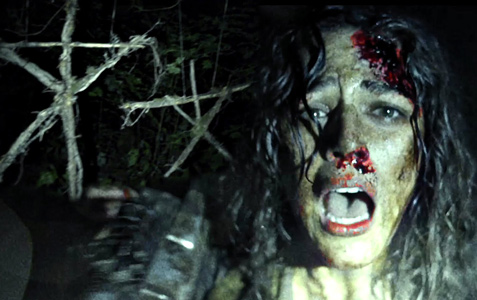Finding Footing with Found Footage: Why the toolset works when used correctly

The term “found footage” can easily evoke eye rolling from genre fans. After a glut of terrible movies using the gimmick as a way to cheaply make films with minimal scares, it’s easy to understand why so many people are hesitant to embrace the tool as a way to tell the story. And it makes sense: it is less expensive to use every day cameras; there’s less attention needed to detail for shot framing and audio control; and lazy scriptwriting can be easily passed off as verisimilitude of how people would talk in a situation. But while there have been many, many terrible films made using the found footage gimmick, there have been enough good films that understand how to use it and showcase why this cinematic tool has survived for over 40 years. With a new “Blair Witch” film on the horizon, using the same technique as the first, it’s time to reflect on how found footage works so well and why people should embrace it (when it’s done right).
As previously stated, there have been multiple good films that use found footage correctly: “Cannibal Holocaust,” “The Last Broadcast,” “The Blair Witch Project,” “Cloverfield,” parts of “V/H/S 2,” “REC” and the “WNUF Halloween Special.” True, for each of these films, there are probably 10 terrible ghost story movies that rely on cheap startling moments without any character development or interesting narrative moments. What sets these films apart from the slogfests of the “Paranormal Activity” imitators are that they are made by people with clear intent, an understanding of tone and atmosphere, and a real investment in telling a story. While others cash in on the “craze” of found footage, these films were made to tell a story using the medium to highlight characterizations and provide a fresh perspective on well-worn territory. So to dismiss this technique outright because of all the weak entries is akin to not watching “Jaws” because of all the hackneyed “man vs. nature” films that came after it.
It’s easy to think of found footage as a subgenre unto itself, but it really it is just a tool, a framing device for telling a story. When done properly, it adds elements to the film that wouldn’t be there if shot like a traditional movie (with set-up shots, intense blocking, polished dialogue, etc.) and immerses the audience in a “reality” that the filmmaker has cultivated. These more realistic elements tend to lend themselves even better to unrealistic happenings, like the zombie plague of “REC,” the horrific tribal brutality of “Cannibal Holocaust,” or the supernatural happenings of “The Blair Witch Project.” By grounding it in the mundane, filmmakers make the horrors hit closer to home and are able to jack up the tension and atmosphere that simply wouldn’t be there in a more polished film.
But there are certain elements that unite these excellent forays and which other found footage films need to address in order to succeed. The first is that there has to be a reason why the camera is still rolling. Often times there’s a throwaway line in the lesser films of this nature, or else it’s simply static security camera (or nanny cam) footage that just happens to capture all of the exciting, startling bits. What makes the aforementioned films work as well as they do is that the reason for the footage is grounded in characterization. The pretentious film students of “Blair Witch Project” live through the camera and see themselves as artists, hence why they are dedicated to capturing everything they can on film. The GoPro footage of the zombie outbreak segment of “V/H/S 2” just happens to still be running as the cyclist is suddenly thrust into an apocalyptic scenario. “Cannibal Holocaust” shows the B-roll and outtakes of the film crew, a group of ugly Americans that have no regard for nature or truth. And it’s these same elements that force them to pursue shooting everything that will ultimately prove to be their hubris, and their downfall.
Admittedly, “Cloverfield” struggles with this, as many characters constantly ask Hutch why he’s still filming and he just suggests that people will want to see it someday. However, as cameras have become more omnipresent with phones and CCTV, and as civilian journalism has risen during horrific events like riots and police altercations, it’s not that farfetched to think that someone would want to filter the experience through the lens. Think about how often you go to a concert and people are filming it with their phones rather than just experiencing it for themselves; that combination of social media narcissism and the need to prove that “you were there” doesn’t seem that ridiculous when measured up with reality.
This also leads to another aspect that great found footage films achieve and more should aspire towards: characterization. The justification for filming is a great insight into the characters’ minds, but what is captured on the film also has to help audiences understand who these people are. This is a bit more ephemeral, as it’s hard to say what makes for good natural dialogue and performances, but it’s incumbent on the cast and directors to make sure that the people seem like regular folks caught up in something greater than themselves, and that they are also relatable in that panic as things go bad. By grounding the film in the characters, even deplorable ones like in “WNUF Halloween Special” or “Cannibal Holocaust,” audiences are more entrenched in the story and the outcome when things get less realistic and the horror unfolds.
Another element that found footage films need to establish and maintain to resonate with viewers is the tone and atmosphere, and that’s done by forcing audiences into the characters’ perspectives as dictated by the limited camera work. This means that not every amazing shot will be captured crisply in the film (like in “The Sacrament,” where it’s all framed too well and shown too professionally). It’s the implications of horrors occurring just outside the shot or through sound editing or obscuring in some way that gets imaginations racing. If the filmmakers have already ground the movie in reality with its characters, then just the insinuation of terror is enough to evoke a reaction from the audience. Even if the camerapeople in the film are supposed to be professionals, when they are in the throes of horror, they will probably not have perfect lighting or capture a shot cleanly. Those little details of imperfection are what adds up in audiences’ minds and allows them to suspend their disbelief and buy into the frightening aspects of what they are watching.
Found footage doesn’t have to be shitty. It doesn’t have to simply be moments of silence and then startling sounds and quick cuts to trick people into having an emotional reaction, mistaking being momentarily aghast with being truly afraid. In fact, as a tool for filmmakers, it can be a great way to ground a high concept film or well-worn territory and present it in a brand new, street-level light. Found footage makes it easier to allow for a false reality to lay claim to an audience for a running time by creating a parallel world that is much closer to our own than those made with a Hollywood sheen. In the wrong hands, it can be a boring exercise in unmemorable performances and predictable scare tactics. But in the right hands, found footage can be the perfect way to make the shadows of our world just a bit darker and the terrors seem that much closer to home.
Related Posts
Comments Off on Finding Footing with Found Footage: Why the toolset works when used correctly
Posted in: Entertainment, Movies
Tags: Cloverfield, found footage, found footage movies, REC, The Blair Witch Project








